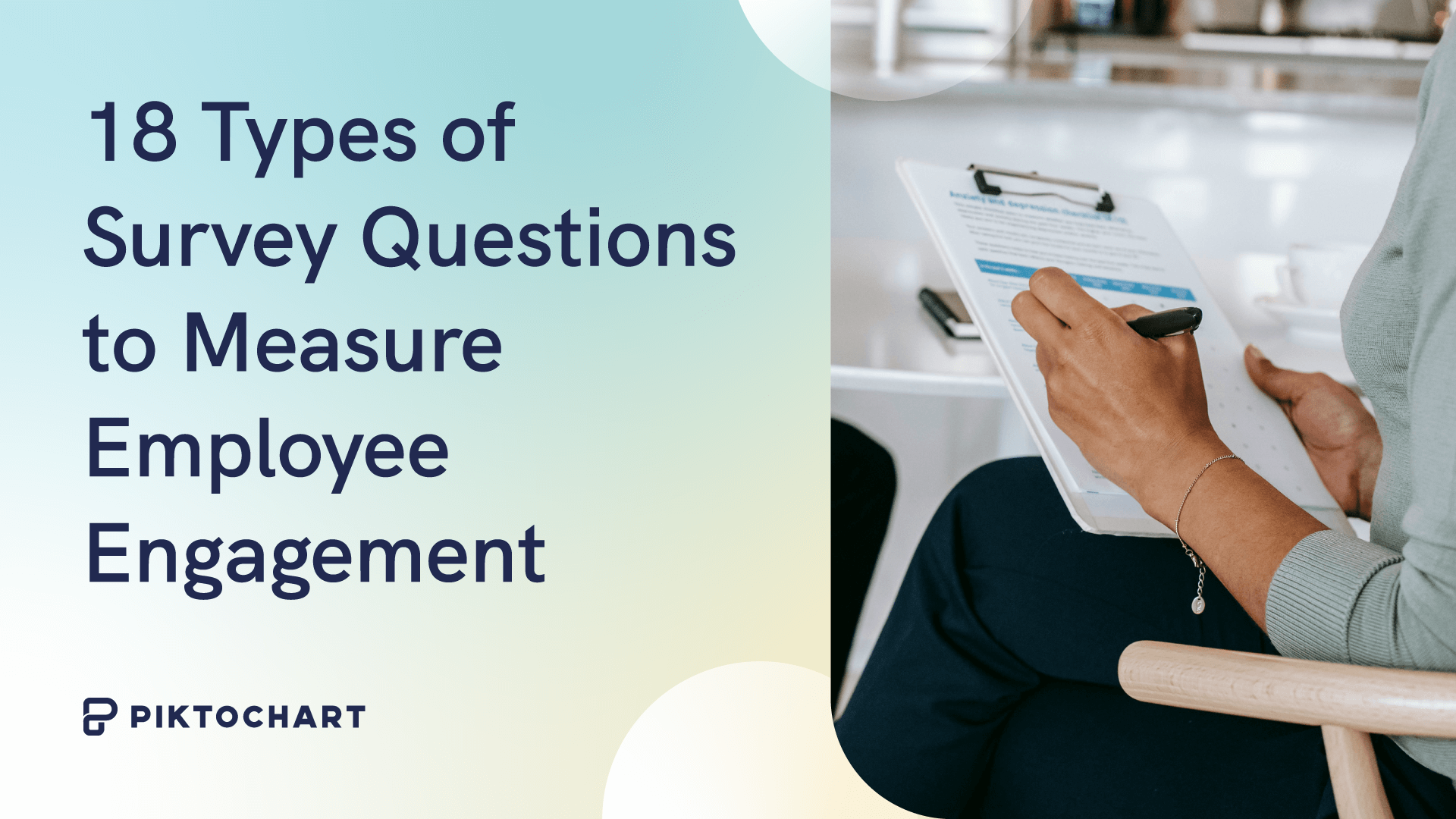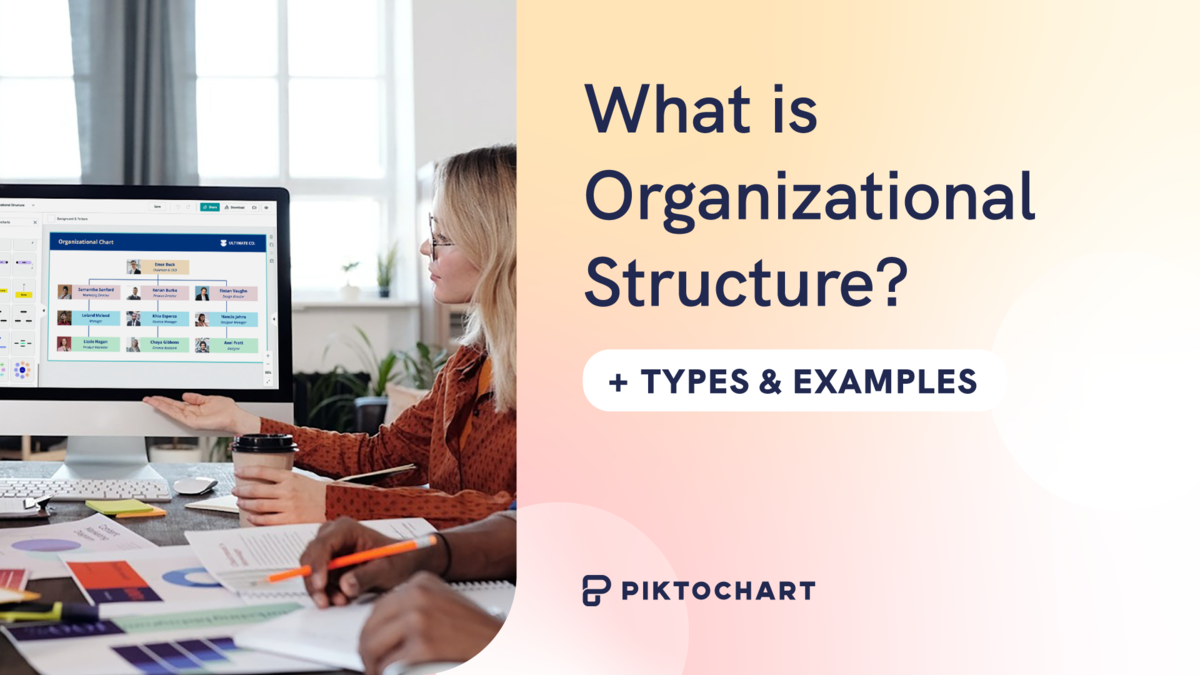Looking to truly understand your teams? It all starts with asking the right questions.
Questionnaires about employee engagement are key to boosting workplace performance. They help pinpoint what motivates your teams and what holds them back.
This guide dives into essential engagement survey questions for 2024. You’ll also learn how to measure employee engagement, create effective surveys, and act on the feedback.
What Is an Employee Engagement Survey
Employee engagement surveys create a direct line into what your employees think and feel about their work.
It’s a strategically designed set of questions that help you assess their motivation, challenges, and overall connection to the company’s goals.
Keep in mind that you need to design surveys that reflect your employees’ expectations and needs.
Why?
Because the primary goal of measuring employee engagement is to collect valuable insights—and implement change.
Why Employee Engagement Surveys Often Fail
Sometimes, despite our best efforts, employee engagement surveys miss the mark. It’s not for lack of trying, but due to a few common mistakes employers tend to make. For example:
Not having a specific goal before launching a survey.
Designing questionnaires in a confusing or ambiguous way.
Creating survey fatigue by conducting too many surveys at once.
Lack of action—failing to address survey feedback and losing trust.
Let’s see how to avoid those mistakes and explore the best questions to include in your employee survey.
18 Best Employee Engagement Survey Questions
Employee engagement covers several areas—from workplace climate and company culture to salary satisfaction and work-life balance.
Below, we list some of the top survey questions from each category.
Workplace Climate

The first set of questions lets you assess the daily work environment in your company. Is it supportive? Does it encourage growth? Now you can find out.
“On a scale from 1 to 10, how would you rate the level of support you receive from your colleagues and superiors?”
This question seeks to understand the support network within your company. Use the employee net promoter (eNPS) question format:
“Do you believe that employees with high potential are actively promoted in our company?” (Never, Rarely, Sometimes, Often, Always)
This question evaluates the opportunities for growth and development in the workplace.
“Do you feel everyone in our company is treated equally regardless of their background or identity?” (Never, Rarely, Sometimes, Often, Always)
Asking this question is essential for assessing diversity and inclusion in your organization.
Company Culture
These questions help you assess the alignment between employees’ experiences and the company’s core values.
“How frequently do team leaders and managers seek employee feedback on decisions affecting your work?” (Never, Rarely, Sometimes, Often, Always)
This question targets the openness and inclusivity of the decision-making process, reflecting on the culture of collaboration in your organization.
“Can you provide an example of how the company’s stated values have directly influenced your work or decision-making process?”
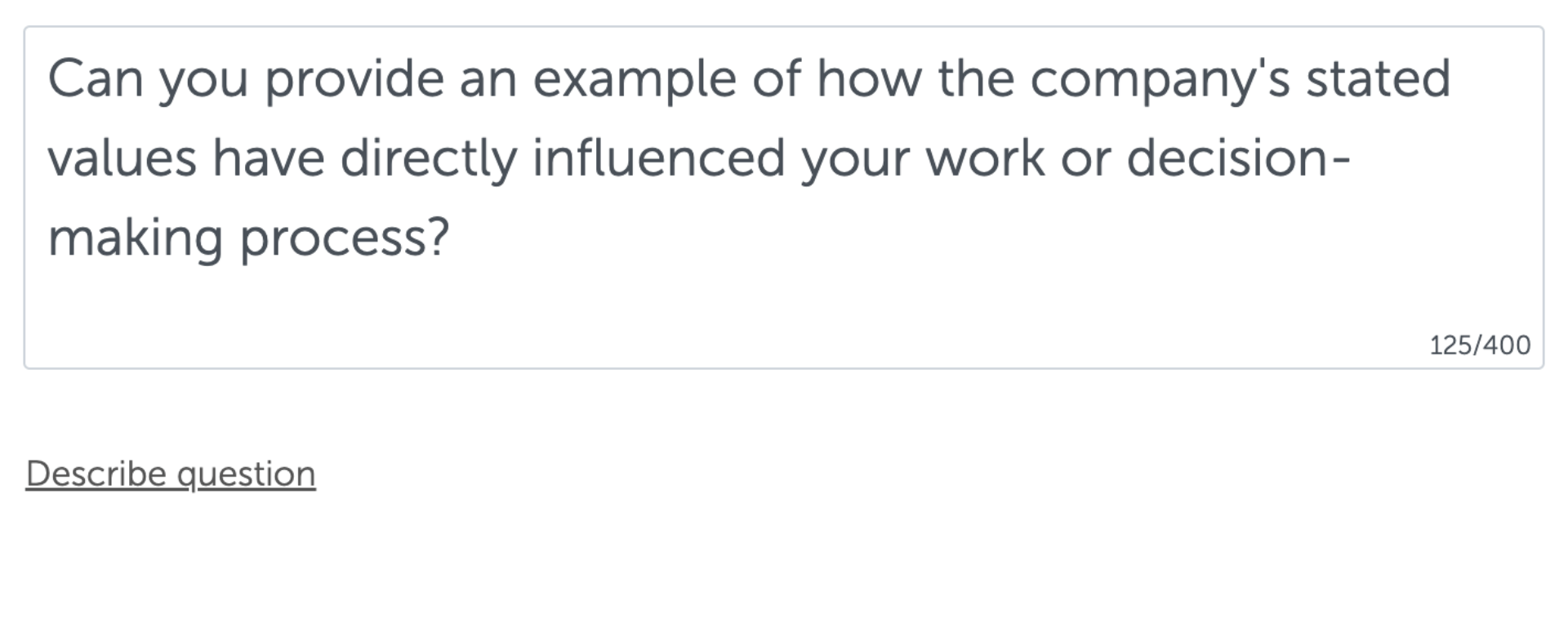
Ask this question to determine whether company policies correlate with official corporate values. You can opt for the open-ended question format:
“Do you receive appropriate recognition when you do a good job?” (Never, Rarely, Sometimes, Often, Always)
This question evaluates the adequacy of recognition employees receive for their achievements, which is essential for engagement.
Salary Satisfaction and Resources
The next group of questions explores satisfaction with benefits and the availability of essential workplace resources.
“How satisfied are you with your current salary and benefits package?”
(Definitely not satisfied, Not really satisfied, Unsure, Mostly satisfied, Absolutely satisfied)
Ask this question to assess employees’ contentment with compensation relative to their roles and responsibilities.
It’s common knowledge that workers who view their compensation as fair show a higher level of engagement and satisfaction.
“Is your workplace equipped with everything you need to do your job well?” (Definitely not, Not really, Unsure, Mostly yes, Absolutely)
This question evaluates whether employees can access the necessary tools and resources for their roles. Those could include training, office facilities, tech, and so on.
“Do you receive the mentoring you need to develop skills for achieving your career goals?” (Never, Rarely, Sometimes, Often, Always)
Use this question to assess the availability and effectiveness of mentoring for personal and career development within the company.
Work-Life Balance
The next group of questions focuses on understanding the balance between work responsibilities and personal time.
“Does your job provide a balance that allows for personal time and responsibilities?” (Definitely not, Not really, Unsure, Mostly yes, Absolutely)
Ask this question to understand if your employees have enough time for their personal lives, which is crucial to avoid burnout.
“Do you find it challenging to manage your current workload?” (Definitely not, Not really, Unsure, Mostly yes, Absolutely)
This question helps you assess if employees have a manageable amount of tasks for their work schedule or if they’re feeling overwhelmed.
“Do you have the flexibility to adjust your work schedule when personal needs arise?” (Definitely not, Not really, Unsure, Mostly yes, Absolutely)
This question explores the degree of work flexibility your teams have to accommodate personal commitments.
Leadership and Management
Next, shift your focus to analyzing how leadership styles and managerial practices affect employee engagement in your company.
On a scale from 1 to 5, how would you rate your current supervisor?
Ask this question to measure trust in leadership—one of the core factors affecting employee engagement.
You can use a star-rating question type to create a simple and effective feedback mechanism:
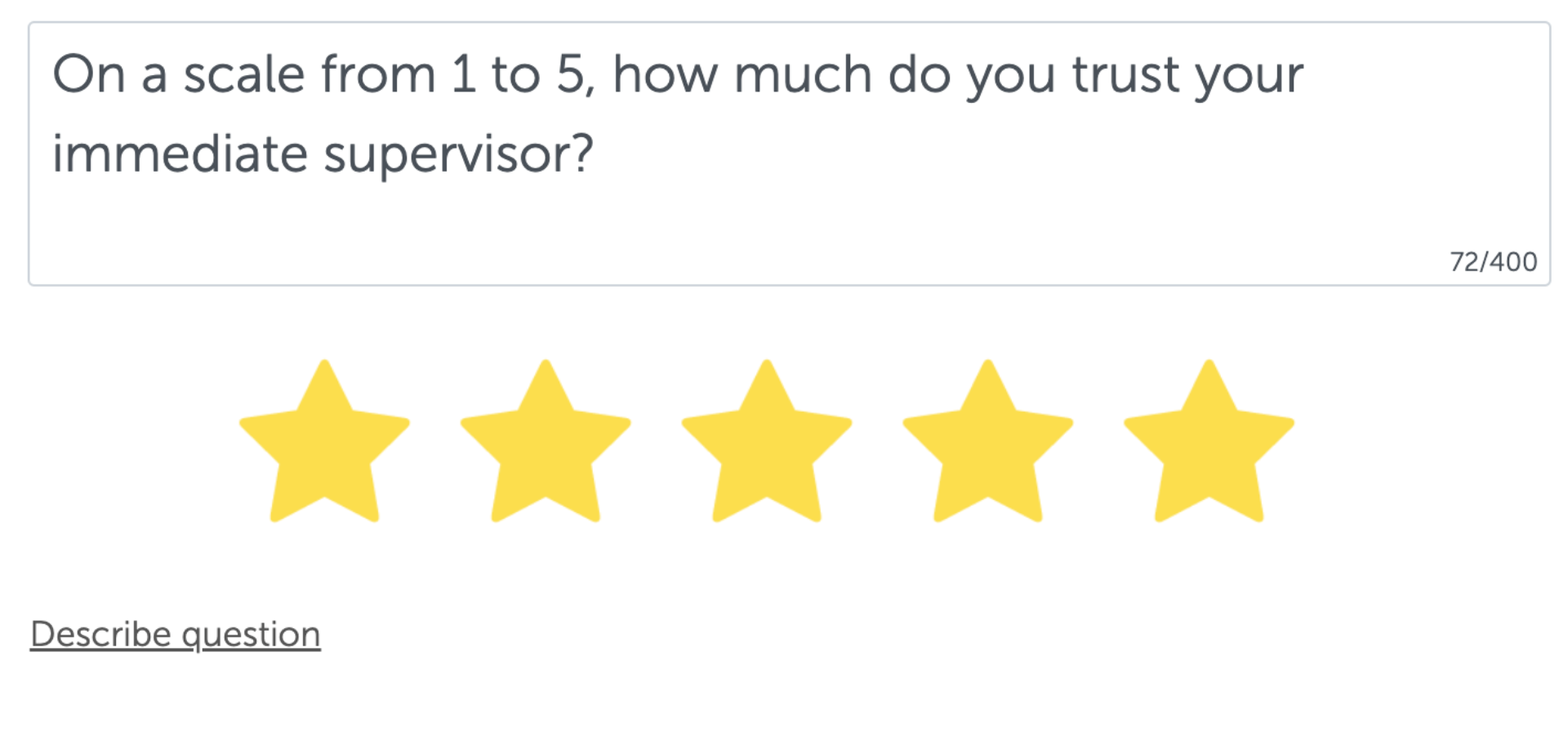
“Does your current supervisor actively support your professional development?” (Definitely not, Not really, Unsure, Mostly yes, Absolutely)
This question helps you assess whether managers in your company focus on fostering their team members’ career growth.
“Do you feel your ideas and contributions are valued by the leadership team?” (Definitely not, Not really, Unsure, Mostly yes, Absolutely)
Your company will prosper if everyone has a chance to contribute and generate ideas. Ask this question to make sure your managers facilitate that process.
Engagement and Motivation
Finally, assess whether your employees feel engaged and motivated with your current work processes.
“Do you usually look forward to starting a new workday?” (Never, Rarely, Sometimes, Often, Always)
Employees’ enthusiasm for work is a solid indicator of their overall satisfaction and engagement.
“Are you proud to work in our organization?” (Definitely not, Not really, Unsure, Mostly yes, Absolutely)
Teams that take pride in their work and their company are much more likely to deliver better results and commit to their organization.
- “How often do you feel inspired and motivated to exceed your job expectations?” (Never, Rarely, Sometimes, Often, Always)
This question measures how often your employees feel engaged enough to go the extra mile to achieve their work goals.
Pro tip:
Add an open-ended question at the end of your survey (or after each section) to learn about specific problems and suggestions from your employees.
For example, if your survey results indicate an issue with leadership, it’s important to understand what causes it and why.
How to Increase Employee Survey Participation
Engaging your team in an employee survey doesn’t have to feel like a chore. With the right approach, you can see participation rates soar.
After all, surveys ensure that your employees have a voice—and their working conditions improve.
However, there are certain best practices to keep in mind if you want to maximize your survey participation.
For example, do your workers believe they can truly drive change? Are your survey questions clear and easy to understand?
Here’s how you can encourage that dialogue.
Explain the Purpose
Before the survey even reaches their inbox, let your employees know why their feedback matters.
Highlight the changes or decisions that previous surveys have influenced and explain the goals of the new questionnaire.
For example, you can explain that the survey results might lead to changes in work-life balance, e.g., a 4-day work week.
Prioritize Anonymity
Emphasize the confidentiality of their responses. Employees are more likely to share honest feedback if they know it won’t be traced back to them.
This is especially true when it comes to evaluating management and colleagues.
Keep it Brief
Respect your team’s schedule by designing a survey that’s quick to complete. A concise questionnaire respects your employees’ time and shows you value their contribution.
Avoid repetitive questions and only ask about areas you’re willing to act on.
Design Unambiguous, Clear Questions
Good phrasing of your survey questions is critical for collecting reliable data. People struggle to answer accurately and tend to drop off when a question is confusing.
It’s also true that certain questions can make your employees feel uneasy—and it’s best to avoid those as well. Let’s look at an example.
|
Effective |
Less effective |
|
“On a scale from 1 to 10, how would you rate the effectiveness of our weekly team meetings?” |
“What do you think about our meetings and how we conduct them?” |
|
“How would you rate your satisfaction with the leadership team’s performance on a scale of 1-10? Please provide specific feedback on areas for improvement.” |
“Who in the leadership team is not doing a great job?” |
|
“How manageable are the current project timelines on a scale of 1-10? Please elaborate on your answer.” |
“Do you think the current project timelines are unrealistic?” |
Let’s analyze each of these examples.
Question one
The effective version of this question uses a 1-10 scale, providing a straightforward way to give feedback.
The second version is too broad and might trigger vague answers that will be difficult to analyze.
Question two
The first question analyzes general sentiment about the leadership team.
You can then compare responses based on departments, locations, etc., and pinpoint specific issues.
The less effective version focuses on identifying weaknesses in individuals and puts your employees in an uncomfortable position.
Question three
The first question aims to assess the current workload, which is more actionable than simply asking if it’s “unrealistic.”
It also provides a clear way to respond, potentially yielding more insights into challenges and bottlenecks.
Choose the Right Time
The moment you start your survey can make a lot of difference. For instance, it’s best to avoid times when people are extremely busy—e.g., at the end of the quarter or before a new product release.
At the same time, try to spot moments where surveys are especially important.
For example, after massive company changes like mergers or shifts in leadership.
Offer Incentives
Not every survey requires an extra incentive. However, a little motivation can help boost participation rates on certain occasions.
For example, you could organize a team pizza party or provide a raffle entry for each completed survey.
Reveal the Results and Take Action
Once you’ve collected the survey results, share your findings with the team and detail your next steps.
This closes the loop, showing your team that their feedback leads to real action and improvement.
Using our work-life balance survey example, you would need to map out an action plan with specific initiatives. These could include reducing the number of meetings, changing the current company structure, and more.
How to Analyze Survey Results and Take Action
Collecting survey responses is just the first step. The real work starts when you take this feedback and turn it into action.
Let’s explore the key steps when analyzing your surveys and creating a detailed plan.
1. Summarize and Group Your Responses
If you’re using a simple survey form, download your data and perform a basic analysis to summarize the results and look for patterns.
For example, you will categorize the open-ended responses into thematic categories—e.g., “Office environment,” “Training and education,” “Feedback mechanisms,” and so on.
To save time, use specialized employee survey tools that leverage AI to analyze and summarize the open-ended questions.
2. Look for Outliers
Are you done analyzing the broad trends and common themes? It’s time to dig deeper and find hidden insights in your data. For example, you can compare:
Departments
Teams
Locations
And so on.
This step can help you spot interesting findings.
Imagine that one office location performs better than all others. Perhaps they implemented certain changes you’d like to replicate?
You can work with a data scientist to carry out this analysis. Alternatively, use a specialized employee survey tool that offers analytics dashboards.
3. Create a Targeted Action Plan
Finally, it’s time to act!
Sort through the issues you’ve identified, ranking them by how much they affect your company and whether they’re actionable.
Sketch out a clear plan on who’s doing what and by when. Specifically, list the roles involved in implementing the changes and set specific targets.
Imagine that your survey revealed that management communication needs a boost. In this case, you might set up monthly all-team meetings, start a bi-weekly newsletter, and allow asking anonymous questions.
The internal branding and HR teams would be responsible for introducing the changes.
To further involve your employees, you can organize working groups to brainstorm the best solutions.
4. Share Your Plan and Keep Everyone Posted
Finally, share survey findings and list the proposed actions. You can do this during a company-wide meeting and follow up with a summary via Slack or email.
Make sure to provide the expected timeline and post regular updates as changes roll out.
Use this free template to quickly put together an employee engagement report.
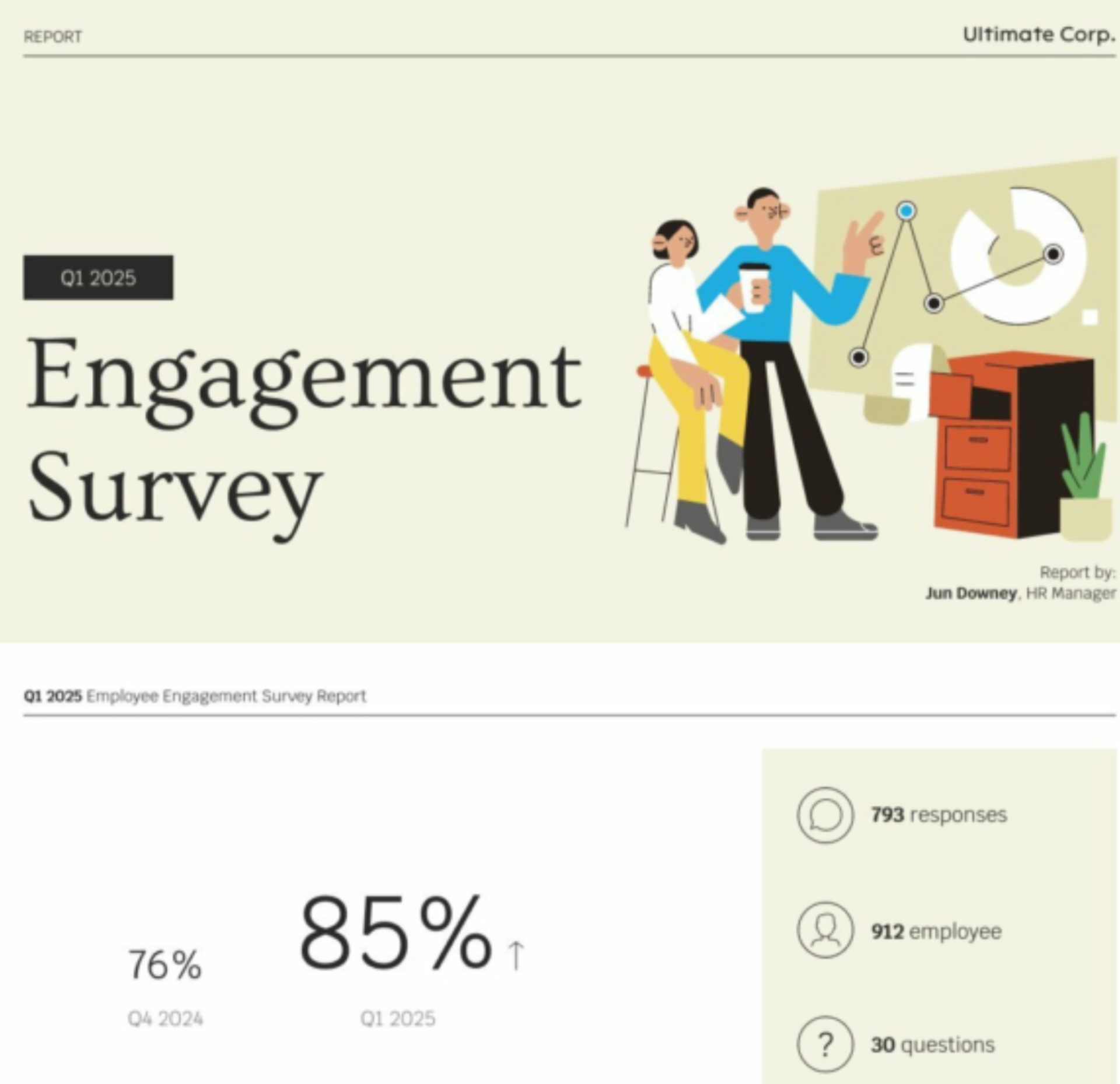
It’s also helpful to design a follow-up questionnaire after implementing your action plan. Were your efforts successful? Do you need to add extra steps?
The best way to find out is to ask your employees.
Boost Employee Engagement the Data-Driven Way
Asking the right questions is key to understanding and engaging your teams.
Focus on measuring the areas that are most important to your business right now. You can ask questions related to:
Workplace climate
Company culture
Work-life balance
Leadership practices
Motivation and engagement
Ensure your surveys are clear, effective, and have a specific goal. Then, analyze the results and create a realistic plan to introduce necessary changes.
Using specialized employee survey software can save you hours of work and ensure accurate data analysis.
Look for tools that offer pre-designed templates, easy-to-use survey builders, and powerful analytics.
